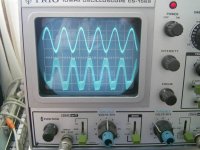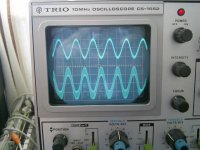Baldin said:the sub is on the new projects page using a peerless XLS driver
The mini-sub was just a first try intended for my PC .... never really finished
It's an excellent site with some very interesting projects. FEMM software seems very interesting, along with what you used it for.
Good luck with the rest of your SODA 🙂

Now i have checked the freq, with the scope set on 2µS/div (500KHz ?)
one period of the triangle waveform extends 1mm more than one division, does that mean around 600KHz ?
Edit reason: got divisions wrong, its 1.1 div with the scope on 2µS/div.
one period of the triangle waveform extends 1mm more than one division, does that mean around 600KHz ?
Edit reason: got divisions wrong, its 1.1 div with the scope on 2µS/div.
Hi, Tekko,
Congratulation, finally.
Don't you need reverse diodes paralleled with R6 to speed up discharging the gates?
Regards,
kartino
Congratulation, finally.
Don't you need reverse diodes paralleled with R6 to speed up discharging the gates?
Regards,
kartino
Nope, nada.
On first run i had no cooling at all on the amp and it took maybe 15 minutes for the fets to heat up.
On first run i had no cooling at all on the amp and it took maybe 15 minutes for the fets to heat up.
kartino!
Of course there is no cross conduction, since IR2111 have a huge dead time! tdon=750, tdoff=150 ns! But what quality can be achieved with this? Especially at this high switching freq? Without feedback...
"1mm more than one division, does that mean around 600KHz ?"
1/2,2us=440kHz.
Edit: Sorry, 454.
Of course there is no cross conduction, since IR2111 have a huge dead time! tdon=750, tdoff=150 ns! But what quality can be achieved with this? Especially at this high switching freq? Without feedback...
"1mm more than one division, does that mean around 600KHz ?"
1/2,2us=440kHz.
Edit: Sorry, 454.
It seems that kartino doesn't interested in any more...
Tekko!
Why don't you show us the output waveform, eg. at 1 kHz?
Tekko!
Why don't you show us the output waveform, eg. at 1 kHz?
What is the output voltage? Obviously very much less then supply voltage, but how many volts? I can see 2 V/div on second channel, so it can be 3 volts. Comment?
I call clipping when output voltage almost reaches supply rails. This is not that case.
I call clipping when output voltage almost reaches supply rails. This is not that case.
- Status
- Not open for further replies.
- Home
- Amplifiers
- Class D
- level shifters and mosfet drivers

 check again? I doubt it.
check again? I doubt it.
